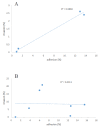Whole-Genome Sequencing Characterization of Virulence Profiles of Listeria monocytogenes Food and Human Isolates and In Vitro Adhesion/Invasion Assessment
- PMID: 35056510
- PMCID: PMC8779253
- DOI: 10.3390/microorganisms10010062
Whole-Genome Sequencing Characterization of Virulence Profiles of Listeria monocytogenes Food and Human Isolates and In Vitro Adhesion/Invasion Assessment
Abstract
Listeria monocytogenes (Lm) is the causative agent of human listeriosis. Lm strains have different virulence potential. For this reason, we preliminarily characterised via Whole-Genome Sequencing (WGS) some Lm strains for their key genomic features and virulence-associated determinants, assigning the clonal complex (CC). Moreover, the ability of the same strains to adhere to and invade human colon carcinoma cell line Caco-2, evaluating the possible correspondence with their genetic virulence profile, was also assessed. The clinical strains typed belonged to clonal complex (CC)1, CC31, and CC101 and showed a very low invasiveness. The Lm strains isolated from food were assigned to CC1, CC7, CC9, and CC121. All CC1 carried the hypervirulence pathogenicity island LIPI-3 in addition to LIPI-1. Premature stop codons in the inlA gene were found only in Lm of food origin belonging to CC9 and CC121. The presence of LIPI2_inlII was observed in all the CCs except CC1. The CC7 strain, belonging to an epidemic cluster, also carried the internalin genes inlG and inlL and showed the highest level of invasion. In contrast, the human CC31 strain lacked the lapB and vip genes and presented the lowest level of invasiveness. In Lm, the genetic determinants of hypo- or hypervirulence are not necessarily predictive of a cell adhesion and/or invasion ability in vitro. Moreover, since listeriosis results from the interplay between host and virulence features of the pathogen, even hypovirulent clones are able to cause infection in immunocompromised people.
Keywords: Listeria monocytogenes; Whole-Genome Sequencing (WGS); adhesion and invasion capacity; pork-meat products; premature stop codon (PMSC); virulence genes.
Conflict of interest statement
The authors declare that they have no known competing financial interests or personal relationships that could have appeared to influence the work reported in this paper.
Figures




Similar articles
-
Listeria monocytogenes Strains Persisting in a Meat Processing Plant in Central Italy: Use of Whole Genome Sequencing and In Vitro Adhesion and Invasion Assays to Decipher Their Virulence Potential.Microorganisms. 2023 Jun 26;11(7):1659. doi: 10.3390/microorganisms11071659. Microorganisms. 2023. PMID: 37512831 Free PMC article.
-
Deciphering the virulence potential of Listeria monocytogenes in the Norwegian meat and salmon processing industry by combining whole genome sequencing and in vitro data.Int J Food Microbiol. 2022 Dec 16;383:109962. doi: 10.1016/j.ijfoodmicro.2022.109962. Epub 2022 Oct 8. Int J Food Microbiol. 2022. PMID: 36240603
-
Intensive Environmental Surveillance Plan for Listeria monocytogenes in Food Producing Plants and Retail Stores of Central Italy: Prevalence and Genetic Diversity.Foods. 2021 Aug 20;10(8):1944. doi: 10.3390/foods10081944. Foods. 2021. PMID: 34441721 Free PMC article.
-
Genomic Determinants of Pathogenicity and Antimicrobial Resistance for 60 Global Listeria monocytogenes Isolates Responsible for Invasive Infections.Front Cell Infect Microbiol. 2021 Oct 27;11:718840. doi: 10.3389/fcimb.2021.718840. eCollection 2021. Front Cell Infect Microbiol. 2021. PMID: 34778102 Free PMC article.
-
Listeria monocytogenes lineages: Genomics, evolution, ecology, and phenotypic characteristics.Int J Med Microbiol. 2011 Feb;301(2):79-96. doi: 10.1016/j.ijmm.2010.05.002. Epub 2010 Aug 13. Int J Med Microbiol. 2011. PMID: 20708964 Review.
Cited by
-
Listeria monocytogenes Pathogenesis: The Role of Stress Adaptation.Microorganisms. 2022 Jul 27;10(8):1522. doi: 10.3390/microorganisms10081522. Microorganisms. 2022. PMID: 36013940 Free PMC article. Review.
-
Listeria monocytogenes Strains Persisting in a Meat Processing Plant in Central Italy: Use of Whole Genome Sequencing and In Vitro Adhesion and Invasion Assays to Decipher Their Virulence Potential.Microorganisms. 2023 Jun 26;11(7):1659. doi: 10.3390/microorganisms11071659. Microorganisms. 2023. PMID: 37512831 Free PMC article.
-
Current methodologies available to evaluate the virulence potential among Listeria monocytogenes clonal complexes.Front Microbiol. 2024 Oct 10;15:1425437. doi: 10.3389/fmicb.2024.1425437. eCollection 2024. Front Microbiol. 2024. PMID: 39493856 Free PMC article. Review.
-
Newly Designed Primers for the Sequencing of the inlA Gene of Lineage I and II Listeria monocytogenes Isolates.Int J Mol Sci. 2022 Nov 15;23(22):14106. doi: 10.3390/ijms232214106. Int J Mol Sci. 2022. PMID: 36430584 Free PMC article.
-
Whole Genome Sequence Analysis of Listeria monocytogenes Isolates Obtained from the Beef Production Chain in Gauteng Province, South Africa.Microorganisms. 2024 May 16;12(5):1003. doi: 10.3390/microorganisms12051003. Microorganisms. 2024. PMID: 38792832 Free PMC article.
References
-
- Barbuddhe S.B., Chakraborty T. Listeria as an enteroinvasive gastrointestinal pathogen. Curr. Top Microbiol. Immunol. 2009;337:173–195. - PubMed
Grants and funding
LinkOut - more resources
Full Text Sources
Other Literature Sources
Molecular Biology Databases

